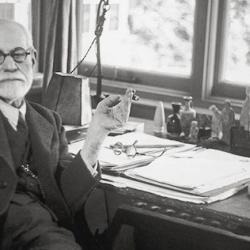Like many Renaissance writers, Shakespeare is obsessed with mutability, with the vaporous quality of human life. Nothing remains forever. Kingdoms rise and fall. Monuments erode and decay. People grow old and die.
This is one of the regular themes of Shakespeare’s sonnets, focused in part on the beauty of the young man who is addressed in the sonnet. He will not remain a fair youth forever. If he wants to reach immortality, to be remembered, he has to do something to overcome the mutability of the world, the threat of death.
Sonnet 3 offers one possibility. The three quatrains are arranged in a chiastic order. The first begins with an invitation to the youth to look in the mirror, “thy glass.” The third quatrain returns to this image, a common one in the sonnets: “Thou art thy mother’s glass.” He is the mirror-image of his mother. Looking in the glass, he can see what sort of mirror image he might form for posterity.
Brett Foster (The Sonnets) writes that the glass enables the young man to “feel beside himself, so to speak—that is, to make him realize how others feel when they see the Young Man’s beauty.” Once he sees himself from the outside, he may be shocked into recognizing how fragile life and beauty are.
The central quatrain has a different focus. Given the qualities that are evident in the glass, there is no woman who would not be wiling to be the womb for his child, ground for him to plough and plant.
We can examine the argument of the sonnet in more detail. The first quatrain attempts to shame the youth into reproducing his image by having a child. He can see his face and his youth in the mirror. Now is the time—now and not later, when he is too old or too ugly—to form another face like the image he sees. If he fails to do this, he will rob the world of a good; he will steal a blessing from the potential mother of his child. The third line emphasizes the renewal that he should be pursuing—fresh, repair, now, renewest. By having a son before he becomes too old, he will keep his fairness fresh and repair the mutability of this aging world.
The second quatrain is a rebuke to the young man. The first two lines emphasize his attractiveness. Any woman with an “unear’d womb”—a womb like a field that is not full of ears of corn—would have him. The analogy between the agriculture and sexuality reflects what older scholars described as “the Elizabethan world picture,” in which poetic analogies are built into the world rather than imposed on it. “Husbandry” means playing the husband to a woman, so she conceives; it also means caring for mother earth and plant life so they become fruitful. This analogy is not the poet’s clever juxtaposition, but inherent in nature and language.
“Tomb” is a somber rhyme for “womb,” the destination of the dead rather than the source of life. What is headed for the tomb? If the youth doesn’t reproduce, his own self-love will go into the tomb, and posterity will die. That is: It’s to his own advantage for the youth to have a child, and he can’t be so silly, insane or “fond” as to kill his own self-interest. If he is so fond, then he will become his own tomb, the tomb of his own self-love. The rhyme starkly sets out the options: Plough and fill a womb, or stand aloof and his body will become tomb of his own self-love.
The third quatrain explains how reproduction is in his own interest. Had his mother been as reluctant as he appears to be to form a face like his own, he would not exist. He would not be his mother’s glass. His resemblance to his mother is a blessing to his own mother, since he revives the “April” of her prime. Again, reproducing is linked to renewal, refreshment, the coming of spring, the time when things bud and bloom. Reproduction is resurrection. If he follows his mother’s lead, he will see his golden youth through his own eyes (“the windows of thing age”), even when he his wrinkled. Reproducing is a blessing to his mother, also a self-blessing.
The final couplet hammers the point home. If he lives in such a way that he leaves no memorial, no image, then he will “die single.” As Foster points out, this means not only that he will die alone, but that he will die full stop, die completely. He will suffer a double death, since both he and the potential-but-not-actual image will go to the tomb together. The final “image” is also an image in the mirror: Once he dies, there will be no way for him to see his reflection in a glass, since there will be no image to mirror him as he mirrors his mother.
In short: Battle mutability, battle age. Reproduce.











